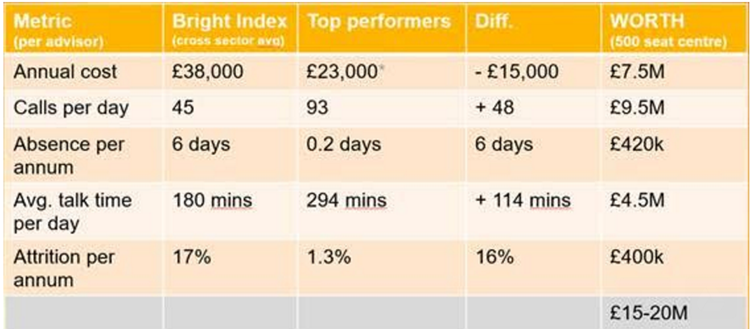Recently, we uncovered that 80% of contact centre managers believed that budget was becoming a major concern in preventing them from running their dream contact centre.
So, we asked our panel of experts to suggest ways to secure more money for the contact centre.
1. Define Your Pain Points
Before you start proposing a case for extra budget, consider whether you are able to clearly identify why change is needed. What is broken or has changed? Do you know what’s holding you back and why you can’t meet your goals?
If you can’t answer, then take a step back and focus time and energy on understanding the ‘real’ reason you need to change. Then identify the costs associated with this challenge and complete a financial analysis.
To do this, you can:
- Consider using the “5 Why’s” methodology to reach root cause
- Map out a SWOT (Strengths, Weaknesses, Opportunities, Threats) analysis of these root causes
- Identify threats and opportunities and define how they will impact both business and contact centre success both now and in the next two years.
2. Consider How Your Contact Centre Is Viewed by the Wider Business
Objectively consider whether senior management view your team as a cost or profit centre. If cost centre, what could you do to show that you are making a real contribution to the success of the business?
Take the time to consider the project from every stakeholder’s point of view. Your project will compete for time and resource from wider stakeholders. Others, such as IT, operations and management, have their own issues.
So, contemplate how your goals impact them. Work with peers to see their picture, find out if they can identify with your pain and consider how your project will help to solve a shared problem.
It may also be useful to plan how to align team actions and improve success, canvass your leader’s opinion, learn about their challenges and present your plan with their context in mind.
3. Work Out the Cost of Doing Nothing
Detail how not acting will impact your team and its productivity. While the human cost has a value, be sure to detail the business cost now and in the medium term. If there is no cost, rethink.

Lynley Meyers
After all, success has two sides: the financial measures and the team engagement. Ensure that you have a clear return on investment and back up the reasons that your project has a compelling priority.
Your challenge has a real cost, usually in both efficiency and morale. You are proposing a solution to remove those costs. There will be real benefits too, so be sure to specifically quantify each cost.
– Thanks to Lynley Meyers at Netcall
4. Prove that the Contact Centre Can Boost Profits
Chief executives will be reluctant to invest in offering a better customer service until seeing proof of it having a positive effect on profits.
A good way to demonstrate this is by measuring:
A. The spend amongst your net promoters
B. What drives Net Promoter Score (NPS).
Generally, this will range from 20-33% more spend amongst promoters, depending on sector.
When linking the various impacts of all their activities on this score, contact centres can monetise the value of additional investment. For example:
- When implementing voice of the customer (VOC) solutions, there will normally be an increase in the number of promoters, with around 20% creating an incredibly compelling business case for the VOC investment.
- By introducing performance metrics alongside NPS, CS directors can present breaking points for metrics, such as speed of answer, team leader v. agent ratio, training days, etc., providing powerful arguments for where more investment is needed (and not).
5. Quantify and Prioritise the Use of Benchmarking
Another good way of showing that you will maximise the investment granted is to present a priority list with analysis of what return on investment (ROI) each area would bring.
In the example below, benchmarking is used to show what investing in different areas to narrow the gap to top performers could mean in terms of cost savings.

Mats Rennstam

But be wary of highlighting areas that you think you are doing poorly in, as you may not get the return you think. Instead, put forward the ones where you will get the most bang for your buck, making your budget stretch further.
– Thanks to Mats Rennstam at Bright
6. Share the Voice of the Customer Throughout Your Organisation
All staff can communicate successes and opportunities after their interactions with customers (clients, end-users, etc.), which can be transmitted right to the top of the business.
By leveraging call recordings and sharing the stories with the executives, this can be taken one step further, to promote the contact centre internally. After all, most executives love to share customer success stories.
Furthermore, evangelizing and influencing the organisation with the data you already have from your voice of the customer program, will allow you to make the business case for additional investments.
7. Show How Improving the Customer Experience Can Impact Loyalty
According to research from the CEB, 94% of customers who have a positive and low-effort service experience will buy from that same company again.

Roger Lee
So, measure what matters to your customers (clients, end-users, etc.) e.g. Net Promoter Score (NPS), Customer Satisfaction (CSAT), Customer Effort Score (CES).
Then, propose to senior management how you can improve these metric results with a greater budget. For example, if you want to improve your CES, show how a bigger budget can provide a clear, single destination point and offer a seamless escalation process.
– Thanks to Roger Lee at OpenText
8. Establish Business Goals and Prove How the Contact Centre Can Meet Them
Getting this clarity regarding business goals from the senior leadership team is really important. Without it, you might put effort into creating a business case that simply won’t be approved.
Many businesses see contact centres as a cost centre rather than a net contributor to the business. If this is the mindset then asking for more budget will be seen as just increasing costs further.

Frank Sherlock
So, you will need to educate budget holders about the real contribution of the contact centre. This will mean going beyond performance KPIs such as number of calls per agent per hour to the revenue generated by agent per hour.
Instead, show how investments can improve advisor productivity and will, in time, drive down the menial costs associated with the contact centre.
– Thanks to Frank Sherlock at CallMiner
9. Acknowledge Your Current and Projected Budgets
If you are currently using an on-premise contact centre, take a look at costs in terms of licence fees and maintenance typically classified as capital expenditure (CAPEX), then consider the same costs for a cloud-based contact centre.

Colin Hay
With cloud technology, costs are dependent on usage and usually regarded as operational expenditure (OPEX). This comparison is particularly valid for seasonal businesses where expensive capital equipment could be underused for long periods of time, or in growing contact centres.
In growing contact centres, it is easier to add additional agents and services using cloud technology and pay for them as you go, rather than face upfront expenditure.
– Thanks to Colin Hay at Puzzel
10. Show How Cloud Adoption Can Put Customers at the Heart of the Business
The key to securing extra budget is putting together a strong business case that demonstrates how the increased expenditure can reduce costs and add value to the bottom line. Moving to the cloud may tick both of these boxes.

Enda Kenneally
Many companies are looking to put customers at the heart of their business processes. Customers want to interact across multiple channels and are ready to change suppliers if organisations do not meet this need.
In this scenario moving to the cloud can seem like a very attractive financial option since it does not involve capital expenditure and can offer organisations the opportunity to redesign their business processes and workflow around their customers’ needs.
– Thanks to Enda Kenneally at West Unified Communications Services
11. Calculate Customer Lifetime Value to Highlight the Cost of the Issue You Want to Address
When putting forward a business case to secure a bigger budget, it is a good idea to provide a quote of the customer’s lifetime value in relation to the issue that you want resolved.
For example, if the average customer has a lifetime value of £1,000 and the issue that you want resolved, with the help of a bigger budget, is costing you eight customers a week, you can demonstrate that the problem is costing the company £8,000 each week.
To put this into context, the company in the example above would be losing £104,000 every week. If that was the case, the contact centre could put forward a proposal to help to combat the issue that would cost much less than £104,000.
For further guidance on building a proposal in the contact centre, read our articles:
- How to Get Skilled in Creating a Business Case
- Proven Ways to Get More Budget for Your Contact Centre
Author: Charlie Mitchell
Published On: 12th Apr 2017 - Last modified: 17th Dec 2024
Read more about - Technology, Bright, Budget, CallMiner, Colin Hay, Editor's Picks, Intrado, OpenText, Puzzel



















